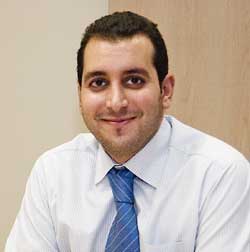Online evaluation process exceeding initial expectations

Rami El-Cheikh sees promotion as key for the successful switch to online.
Photo by Rob Maguire
So far, online student evaluations have been a resounding success at Concordia.
When Vice-Provost (Academic Programs) Danielle Morin piloted the process for the graduate programs of the JMSB last fall, she anticipated fewer responses. The literature had indicated that most institutions experienced a dip in response rates as students adapted to the new system.
So, an aggressive promotional campaign of posters and in class visits accompanied the email invitation each eligible student received. By the end of the three-week response period, 81 per cent of students had completed their online evaluations.
Even more impressively, 78 per cent completed the winter term ones, with a greatly reduced promotional push.
This last term saw the project expanded to the entire ENCS faculty, undergrads and grads alike. They had a record 72.23 per cent response rate, considerably higher than the 60 per cent rate they had been hovering at previously.
“I think we are really leaders in this field,” said Rami El-Cheikh, Special Project Manager in Morin’s office. He added that he had just received a call from representatives of Dawson College for advice on how to introduce the process there.
El-Cheikh thinks promotion is key to making the transition as smooth as possible, especially in the early stages.
Evaluations are managed through the portal, so only registered students can participate. El-Cheikh said that the move to online evaluations offers a number of benefits. Students have a longer time to think about their responses, and can do so at their own convenience.
By eliminating paper, the process is more environmentally friendly. Since everything is managed electronically, professors can get the results of the evaluations far more quickly than the handwritten evaluations allow.
The system maintains the same checks and balances as the traditional structure. Students must submit their evaluations before the finals take place, so that their answers are not influenced by a brutal exam. Meanwhile, profs do not get the results until they have submitted their final marks.
The questions posed are identical to the ones on the written evaluation. “Nothing has changed, not even a dot or a comma,” El-Cheikh stressed. Olivia Rovinescu, of the Centre for Teaching and Learning Services, was involved in translating the questions to a screen friendly format to make sure that the user experience/options would not be altered by the technology. Tuan Mai of IITS developed the software, which had to be created from scratch to operate within our systems.